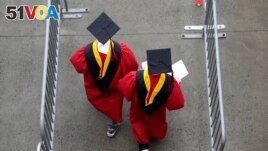28 February 2023
The United States Supreme Court began hearing arguments on Tuesday about President Joe Biden's student debt relief plan. The court's decision will affect millions of borrowers who could see their loans reduced or forgiven.
How does the plan work?
The Biden administration announced the debt forgiveness plan in August of last year. It would cancel $10,000 in federal student loan debt for individuals making less than $125,000 per year or for households making less than $250,000 per year. People who received a Pell Grant, a kind of special financing given to those who show higher financial need, would get an additional $10,000 of debt forgiven.

FILE - New graduates walk into the High Point Solutions Stadium before the start of the Rutgers University graduation ceremony, in Piscataway Township, New Jersey, May 13, 2018.
College students can be a part of the plan if their loans were sent out, or distributed, before July 1 of last year. The plan would permit 43 million borrowers to get some debt forgiveness. About 20 million people could see their debt disappear completely, the Biden administration says.
The White House says 26 million people have applied for debt relief. Around 16 million people had already had their relief approved before courts suspended the program. The Congressional Budget Office has said the program will cost around $400 billion over the next thirty years.
Why the Supreme Court?
The Supreme Court is hearing two arguments against the plan. One involves six states, all led by members of the Republican Party. The other involves a legal action brought by two students.
A lower court dismissed the lawsuit involving the states, which are Arkansas, Iowa, Kansas, Missouri, Nebraska and South Carolina. The court said the states could not legally protest the program because they were not harmed by it.
The states appealed the decision and the U.S. Court of Appeals ruled to suspend operation of the program. Then, the Supreme Court agreed to consider the case.
The students' case involves Myra Brown, who is not able to receive debt relief because her loans are privately held. It also involves Alexander Taylor, who is only able to get $10,000 and not the full $20,000 because he did not receive a Pell grant. The students say that the Biden administration did not go through the correct process in putting the plan into action.
Texas-based U.S. District Judge Mark Pittman, an appointee of President Donald Trump, agreed with the students and ruled to block the program. Pittman ruled that the Biden administration did not have clear permission from Congress to begin the program. A federal appeals court left Pittman's ruling in place, and the Supreme Court agreed to take up the case along with the states' challenge.
Legal basis of plan
To cancel student loan debt, the Biden administration is using the Higher Education Relief Opportunities for Students Act, commonly known as the HEROES Act. Put in place after the Sept. 11, 2001, terror attacks, the law was designed to protect service members from financial loss while they fought in wars in Afghanistan and Iraq. The law permits the secretary of education to waive or change the terms of federal student loans as necessary in connection with a national emergency.
Trump, a Republican, declared the COVID-19 pandemic a national emergency in March 2020. But Biden recently announced that the national emergency will end on May 11. The Biden administration has said that the end to the national emergency does not change the legal argument for student loan debt cancellation because the pandemic affected millions of student borrowers who might have fallen behind on their loans during the emergency.
Likely questions
The Supreme Court will likely pay careful attention to several big issues.
The first one is whether the states and the two student borrowers have the right to sue over the plan in the first place, a legal idea called "standing."
If the court finds that there is no standing, then the Biden administration will be clear to go ahead with the plan. To prove they have standing, the states and borrowers will have to show in part that they are financially harmed by the plan.
Beyond the question of standing, the justices will also be asking whether the HEROES Act gives the Biden administration the power to put the plan into action and how it went about doing so.
I'm John Russell.
And I'm Ashley Thompson.
Jessica Gresko reported on this story for the Associated Press. John Russell adapted it for VOA Learning English.
__
Words in This Story
relief – n. things (such as food, money, or medicine) that are given to help people who are victims of a war, earthquake, flood, etc.; the removal or reducing of something that is painful or unpleasant
apply – v. to ask formally for something (such as a job, admission to a school, a loan, etc.) usually in writing
challenge – n. the act of saying or showing that (something) may not be true, correct, or legal
waive – v. to officially say that you will not use or require something that you are allowed to have or that is usually required











